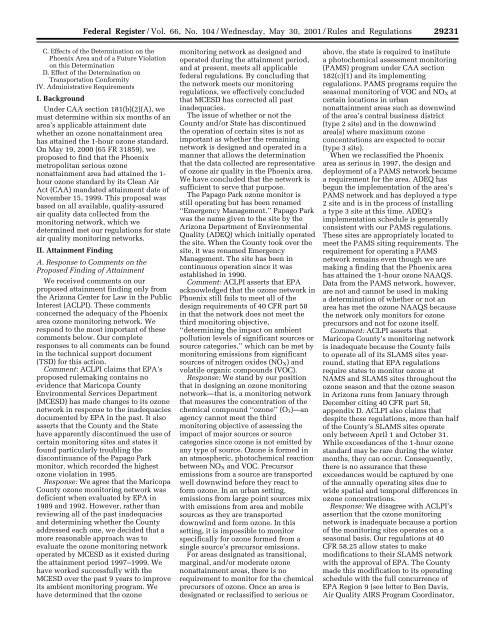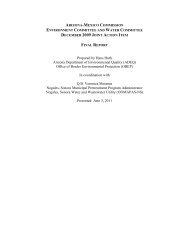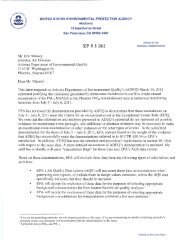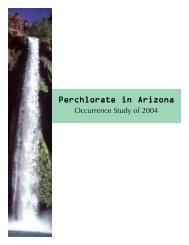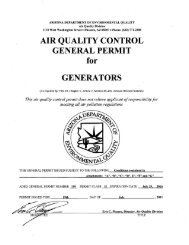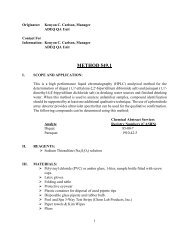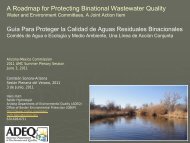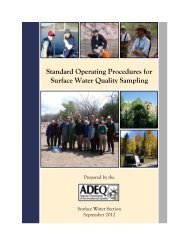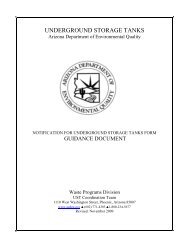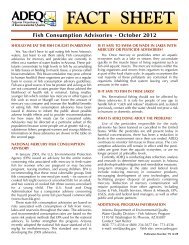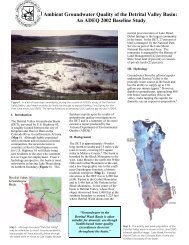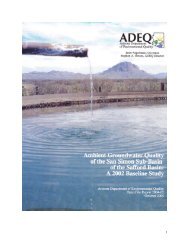66 FR 29230 - Determination of Attainment of the - U.S. Government ...
66 FR 29230 - Determination of Attainment of the - U.S. Government ...
66 FR 29230 - Determination of Attainment of the - U.S. Government ...
- No tags were found...
Create successful ePaper yourself
Turn your PDF publications into a flip-book with our unique Google optimized e-Paper software.
Federal Register / Vol. <strong>66</strong>, No. 104 / Wednesday, May 30, 2001 / Rules and Regulations29231C. Effects <strong>of</strong> <strong>the</strong> <strong>Determination</strong> on <strong>the</strong>Phoenix Area and <strong>of</strong> a Future Violationon this <strong>Determination</strong>D. Effect <strong>of</strong> <strong>the</strong> <strong>Determination</strong> onTransportation ConformityIV. Administrative RequirementsI. BackgroundUnder CAA section 181(b)(2)(A), wemust determine within six months <strong>of</strong> anarea’s applicable attainment datewhe<strong>the</strong>r an ozone nonattainment areahas attained <strong>the</strong> 1-hour ozone standard.On May 19, 2000 (65 <strong>FR</strong> 31859), weproposed to find that <strong>the</strong> Phoenixmetropolitan serious ozonenonattainment area had attained <strong>the</strong> 1-hour ozone standard by its Clean AirAct (CAA) mandated attainment date <strong>of</strong>November 15, 1999. This proposal wasbased on all available, quality-assuredair quality data collected from <strong>the</strong>monitoring network, which wedetermined met our regulations for stateair quality monitoring networks.II. <strong>Attainment</strong> FindingA. Response to Comments on <strong>the</strong>Proposed Finding <strong>of</strong> <strong>Attainment</strong>We received comments on ourproposed attainment finding only from<strong>the</strong> Arizona Center for Law in <strong>the</strong> PublicInterest (ACLPI). These commentsconcerned <strong>the</strong> adequacy <strong>of</strong> <strong>the</strong> Phoenixarea ozone monitoring network. Werespond to <strong>the</strong> most important <strong>of</strong> <strong>the</strong>secomments below. Our completeresponses to all comments can be foundin <strong>the</strong> technical support document(TSD) for this action.Comment: ACLPI claims that EPA’sproposed rulemaking contains noevidence that Maricopa CountyEnvironmental Services Department(MCESD) has made changes to its ozonenetwork in response to <strong>the</strong> inadequaciesdocumented by EPA in <strong>the</strong> past. It alsoasserts that <strong>the</strong> County and <strong>the</strong> Statehave apparently discontinued <strong>the</strong> use <strong>of</strong>certain monitoring sites and states itfound particularly troubling <strong>the</strong>discontinuance <strong>of</strong> <strong>the</strong> Papago Parkmonitor, which recorded <strong>the</strong> highestozone violation in 1995.Response: We agree that <strong>the</strong> MaricopaCounty ozone monitoring network wasdeficient when evaluated by EPA in1989 and 1992. However, ra<strong>the</strong>r thanreviewing all <strong>of</strong> <strong>the</strong> past inadequaciesand determining whe<strong>the</strong>r <strong>the</strong> Countyaddressed each one, we decided that amore reasonable approach was toevaluate <strong>the</strong> ozone monitoring networkoperated by MCESD as it existed during<strong>the</strong> attainment period 1997–1999. Wehave worked successfully with <strong>the</strong>MCESD over <strong>the</strong> past 9 years to improveits ambient monitoring program. Wehave determined that <strong>the</strong> ozonemonitoring network as designed andoperated during <strong>the</strong> attainment period,and at present, meets all applicablefederal regulations. By concluding that<strong>the</strong> network meets our monitoringregulations, we effectively concludedthat MCESD has corrected all pastinadequacies.The issue <strong>of</strong> whe<strong>the</strong>r or not <strong>the</strong>County and/or State has discontinued<strong>the</strong> operation <strong>of</strong> certain sites is not asimportant as whe<strong>the</strong>r <strong>the</strong> remainingnetwork is designed and operated in amanner that allows <strong>the</strong> determinationthat <strong>the</strong> data collected are representative<strong>of</strong> ozone air quality in <strong>the</strong> Phoenix area.We have concluded that <strong>the</strong> network issufficient to serve that purpose.The Papago Park ozone monitor isstill operating but has been renamed‘‘Emergency Management.’’ Papago Parkwas <strong>the</strong> name given to <strong>the</strong> site by <strong>the</strong>Arizona Department <strong>of</strong> EnvironmentalQuality (ADEQ) which initially operated<strong>the</strong> site. When <strong>the</strong> County took over <strong>the</strong>site, it was renamed EmergencyManagement. The site has been incontinuous operation since it wasestablished in 1990.Comment: ACLPI asserts that EPAacknowledged that <strong>the</strong> ozone network inPhoenix still fails to meet all <strong>of</strong> <strong>the</strong>design requirements <strong>of</strong> 40 C<strong>FR</strong> part 58in that <strong>the</strong> network does not meet <strong>the</strong>third monitoring objective,‘‘determining <strong>the</strong> impact on ambientpollution levels <strong>of</strong> significant sources orsource categories,’’ which can be met bymonitoring emissions from significantsources <strong>of</strong> nitrogen oxides (NO X ) andvolatile organic compounds (VOC).Response: We stand by our positionthat in designing an ozone monitoringnetwork—that is, a monitoring networkthat measures <strong>the</strong> concentration <strong>of</strong> <strong>the</strong>chemical compound ‘‘ozone’’ (O 3 )—anagency cannot meet <strong>the</strong> thirdmonitoring objective <strong>of</strong> assessing <strong>the</strong>impact <strong>of</strong> major sources or sourcecategories since ozone is not emitted byany type <strong>of</strong> source. Ozone is formed inan atmospheric, photochemical reactionbetween NO X and VOC. Precursoremissions from a source are transportedwell downwind before <strong>the</strong>y react t<strong>of</strong>orm ozone. In an urban setting,emissions from large point sources mixwith emissions from area and mobilesources as <strong>the</strong>y are transporteddownwind and form ozone. In thissetting, it is impossible to monitorspecifically for ozone formed from asingle source’s precursor emissions.For areas designated as transitional,marginal, and/or moderate ozonenonattainment areas, <strong>the</strong>re is norequirement to monitor for <strong>the</strong> chemicalprecursors <strong>of</strong> ozone. Once an area isdesignated or reclassified to serious orabove, <strong>the</strong> state is required to institutea photochemical assessment monitoring(PAMS) program under CAA section182(c)(1) and its implementingregulations. PAMS programs require <strong>the</strong>seasonal monitoring <strong>of</strong> VOC and NO X atcertain locations in urbannonattainment areas such as downwind<strong>of</strong> <strong>the</strong> area’s central business district(type 2 site) and in <strong>the</strong> downwindarea(s) where maximum ozoneconcentrations are expected to occur(type 3 site).When we reclassified <strong>the</strong> Phoenixarea as serious in 1997, <strong>the</strong> design anddeployment <strong>of</strong> a PAMS network becamea requirement for <strong>the</strong> area. ADEQ hasbegun <strong>the</strong> implementation <strong>of</strong> <strong>the</strong> area’sPAMS network and has deployed a type2 site and is in <strong>the</strong> process <strong>of</strong> installinga type 3 site at this time. ADEQ’simplementation schedule is generallyconsistent with our PAMS regulations.These sites are appropriately located tomeet <strong>the</strong> PAMS siting requirements. Therequirement for operating a PAMSnetwork remains even though we aremaking a finding that <strong>the</strong> Phoenix areahas attained <strong>the</strong> 1-hour ozone NAAQS.Data from <strong>the</strong> PAMS network, however,are not and cannot be used in makinga determination <strong>of</strong> whe<strong>the</strong>r or not anarea has met <strong>the</strong> ozone NAAQS because<strong>the</strong> network only monitors for ozoneprecursors and not for ozone itself.Comment: ACLPI asserts thatMaricopa County’s monitoring networkis inadequate because <strong>the</strong> County failsto operate all <strong>of</strong> its SLAMS sites yearround,stating that EPA regulationsrequire states to monitor ozone atNAMS and SLAMS sites throughout <strong>the</strong>ozone season and that <strong>the</strong> ozone seasonin Arizona runs from January throughDecember citing 40 C<strong>FR</strong> part 58,appendix D. ACLPI also claims thatdespite <strong>the</strong>se regulations, more than half<strong>of</strong> <strong>the</strong> County’s SLAMS sites operateonly between April 1 and October 31.While exceedances <strong>of</strong> <strong>the</strong> 1-hour ozonestandard may be rare during <strong>the</strong> wintermonths, <strong>the</strong>y can occur. Consequently,<strong>the</strong>re is no assurance that <strong>the</strong>seexceedances would be captured by one<strong>of</strong> <strong>the</strong> annually operating sites due towide spatial and temporal differences inozone concentrations.Response: We disagree with ACLPI’sassertion that <strong>the</strong> ozone monitoringnetwork is inadequate because a portion<strong>of</strong> <strong>the</strong> monitoring sites operates on aseasonal basis. Our regulations at 40C<strong>FR</strong> 58.25 allow states to makemodifications to <strong>the</strong>ir SLAMS networkwith <strong>the</strong> approval <strong>of</strong> EPA. The Countymade this modification to its operatingschedule with <strong>the</strong> full concurrence <strong>of</strong>EPA Region 9 (see letter to Ben Davis,Air Quality AIRS Program Coordinator,VerDate 112000 14:35 May 29, 2001 Jkt 194001 PO 00000 Frm 00017 Fmt 4700 Sfmt 4700 E:\<strong>FR</strong>\FM\30MYR1.SGM pfrm06 PsN: 30MYR1


